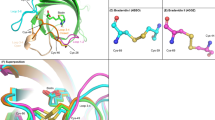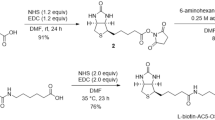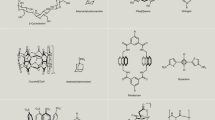Abstract
We report the construction of chimeric streptavidin tetramers that are composed of subunits of both wild-type (WT) streptavidin and genetically-engineered streptavidin variants designed for enhanced bioseparation and drug delivery performance. Subunit mixing is accomplished by guanidine thiocyanate-induced denaturation of an equimolar mixture of WT streptavidin and the respective site-directed mutant, followed by renaturation and reassociation of mixed tetramers. In the first example, we demonstrate the mixing of WT subunits with an Asn49Cys (N49C) mutant. The WT/N49C tetramers can be used for site-specific and stoichiometric attachment of therapeutics/imaging agents or targeting proteins through the genetically-engineered thiol while retaining unhindered access to biotin-binding at the WT subunits. Second, we demonstrate that the Hisl27Cys mutation (H127C) results in a streptavidin mutant that forms a disulfide-linked dimer under non-reducing conditions. Mixing of H127C and WT streptavidin subunits results in chimeric tetramers where both the stoichiometry (WT:H127C::1:1) and subunit architecture is controlled by the unique disulfide bridge engineered into H127C. In the third example, WT subunits were mixed with the subunits of a site-directed mutant, Trpl20Ala (W120A), which displays a biotin dissociation constant that is enhanced by more than 104 compared to WT streptavidin. The W120A biotin-binding affinity is sufficiently high (Ka ≈107 M−1) to immobilize the mutant on a biotin-agarose affinity chromatography column, but the engineered off-rate allows for facile elution with excess biotin at physiological pH, whereas WT streptavidin is irreversibly immobilized on the column. We demonstrate that the purified WT/W120A chimeric tetramers combine the advantages of both subunits, allowing for irreversible immobilization of biotinylated targets at the WT subunit, while retaining the reversible separation capabilities of the W120A subunits via biotin-agarose affinity chromatography.
This is a preview of subscription content, access via your institution
Access options
Subscribe to this journal
Receive 12 print issues and online access
$209.00 per year
only $17.42 per issue
Buy this article
- Purchase on Springer Link
- Instant access to full article PDF
Prices may be subject to local taxes which are calculated during checkout
Similar content being viewed by others
References
Wilchek, M. and Bayer, E.A. 1990. Avidin-biotin technology. Methods Enzymol. 184: 5–13; ibid, 14–45.
Rosebrough, S.F. 1993. Pharmacokinetics and biodistribution of radiolabeled avidin, streptavidin and biotin. Nucl. Med. Biol. 20: 663–668.
Hnatowich, D.J. 1994. The in vivo uses of streptavidin and biotin: a short progress report. Nucl. Med. Commun. 15: 575–577.
Hnatowich, D.J., Virzi, F. and Rusckowski, M. 1987. Investigations of avidin and biotin for imaging applications. J. Nucl. Med. 28: 1294–1302.
Paganelli, G., Riva, P., Deleide, G., Clivio, A., Chiolerio, F., Scassellati, G.A., Malcovati, M. and Siccardi, A.G. 1988. In vivo labelling of biotinylated monoclonal antibodies by radioactive avidin: a strategy to increase tumor radiolocalization. Int. J. Cancer Suppl. 2: 121–125.
Oehr, P., Westermann, J. and Biersack, H.J. 1988. Streptavidin and biotin as potential tumor imaging agents. J. Nucl. Med. 29: 728–729.
Kalofonos, H.P., Rusckowski, M., Siebecker, D.A., Sivolapenko, G.B., Snook, D., Lavender, J.P., Epenetos, A.A. and Hnatowich, D.J. 1990. Imaging of tumor in patients with indium-111 -labeled biotin and sueptavidin-conjugated antibodies: preliminary communication. J. Nucl. Med. 31: 1791–1796.
Paganelli, G., Magnani, P. and Fazio, F. 1993. Pretargeting of carcinomas with the avidin-biotin system. Int. J. Biol. Markers. 8: 155–9.
Paganelli, G., Pervez, S., Siccardi, A.G., Rowlinson, G., Deleide, G., Chiolerio, F., Malcovati, M., Scassellati, G.A. and Epenetos, A.A. 1991. Intraperitoneal radio-localization of tumors pre-targeted by biotinylated monoclonal antibodies. Int. J. Cancer 45: 1184–1189.
Paganelli, G., Malcovati, M. and Fazio, F. 1990. Monoclonal antibody pretargeting techniques for tumour localization: the avidin-biotin system. Nucl. Med. Commun. 12: 211–234.
Green, N.M. 1975. Avidin. Adv. Prot. Chem. 29: 85–143.
Weber, P.C., Ohlendorf, D.H., Wendoloski, J.J. and Salemme, F.R. 1989. Structural origins of high-affinity biotin binding to streptavidin. Science 243: 85–88.
Hendrickson, W.A., Pahler, A., Smith, J.L., Satow, Y., Merritt, E.A. and Phizackerley, R.P. 1989. Crystal structure of core streptavidin determined from multiwavelength anomalous diffraction of synchrotron radiation. Proc. Natl. Acad. Sci. USA 86: 2190–2194.
Sano, T. and Cantor, C.R. 1991. A streptavidin-protein A chimera that allows one-step production of of a variety of specific antibody conjugates. Bio/Technology 9: 1377–1381.
Sano, T., Glazer, A.N. and Cantor, C.R. 1992. A streptavidin-metallothionein chimera that allows specific labeling of biological materials with many different heavy metal ions. Proc. Natl. Acad. Sci. USA 89: 1534–1538.
Dubel, S., Breitling, F., Kontermann, R., Schmidt, T., Skerra, A. and Little, M. 1995. Bifunctional and multimeric complexes of streptavidin fused to single chain antibodies (scFv). J. Immunol. Methods 178: 201–209.
Carter, P., Bedouelle, H. and Winter, G. 1986. Construction of heterodimer tyrosyl-tRNA synthetase shows tRNATyr interacts with both subunits. Proc. Natl. Acad. Sci. USA 83: 1189–1192.
Ward, W.H., Jones, D.H. and Fersht, A.R. 1986. Protein engineering of homodimeric tyrosyl-tRNA synthetase to produce active heterodimers. J. Biol. Chem. 261: 9576–9578.
Carreras, C.W., Costi, P.M. and Santi, D.V. 1994. Heterodimeric thymidylate synthases with c-terminal deletion on one subunit. J. Biol. Chem. 269: 12444–12446.
Erijman, L. and Weber, G. 1991. Oligomeric protein associations: transition from stochastic to deterministic equilibrium. Biochemistry 30: 1595–1599.
Erijman, L. and Weber, G. 1993. Use of sensitized fluorescence for the study of the exchange of subunits in protein aggregates. Photochem. Photobiol. 57: 411–415.
Chilkoti, A., Tan, P.H. and Stayton, P.S. 1995. Site-directed mutagenesis studies of the high-affinity streptavidin-biotin complex. Proc. Natl. Acad. Sci. USA 92: 1754–1758.
Chilkoti, A. and Stayton, P.S. Molecular origins of the slow dissociation kinetics of the streptavidin-biotin complex. J. Am. Chem. Soc. In press.
Kurzban, G.P., Bayer, E.A., Wilchek, M. and Horowitz, P.M. 1990. The quaternary structure of streptavidin in urea. J. Biol. Chem. 266: 14470–14477.
Cuatrecasas, P. and Wilchek, M. 1969. Single-step purification of avidin from egg white by affinity chromatography on biocytin-sepharose columns. Biochem. Biophys. Res. Commun. 33: 235–239.
Heney, G. and Orr, G.A. 1981. The purification of avidin and its derivatives on 2- iminobiotin-6-aminohexyl-sepharose 4B. Anal. Biochem. 114: 92–96.
Orr, G. 1981. The use of the 2-iminobiotin-avidin interaction for the selective retrieval of labeled plasma membrane components. J. Biol. Chem. 256: 761–766.
Hoffman, K., Wood, S.W., Brinton, C.C., Montbellier, J.A. and Finn, F.F. 1980. Iminobiotin affinity columns and their application to retrieval of streptavidin. Proc. Natl. Acad. Sci. USA 77: 4666–4668.
Light-Wahl, K.J., Schwartz, B.L. and Smith, R.D. 1994. Observation of the noncovalent quaternary associations of proteins by electrospray ionization mass spectrometry. J. Am. Chem. Soc. 116: 5271–5278.
Schwartz, B.L., Light-Wahl, K.J. and Smith, R.D. 1994. Observation of noncovalent complexes of the avidin tetramer by electrospray ionization mass spectrometry. J. Am. Soc. Mass Spectrom. 5: 201–204.
Schwartz, B.L., Bruce, J.E., Anderson, G.A., Hofstadler, S.A., Rockwood, A.L., Smith, R.D., Chilkoti, A. and Stayton, P.S. 1995. Dissociation of tetrameric ions of noncovalent streptavidin complexes formed by electrospray ionization. J. Am. Soc. Mass Spectrom. 6: 459–465.
Kohanski, R.A. and Lane, M.D. 1990. Monovalent avidin affinity columns. Meth. Enzymol. 184: 194–200.
Author information
Authors and Affiliations
Corresponding author
Rights and permissions
About this article
Cite this article
Chilkoti, A., Schwartz, B., Smith, R. et al. Engineered Chimeric Streptavidin Tetramers as Novel Tools for Bioseparations and Drug Delivery. Nat Biotechnol 13, 1198–1204 (1995). https://doi.org/10.1038/nbt1195-1198
Received:
Accepted:
Issue Date:
DOI: https://doi.org/10.1038/nbt1195-1198



